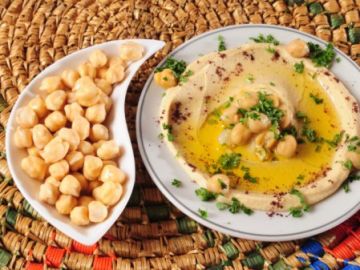Read time – 4 minutes
Turkish food is a feast for all the senses, not just the taste buds. This vibrant, colourful cuisine can be smelt wafting through the streets at mealtimes; expect to be left salivating over the scent of kebabs unlike anything you’ve seen before, sticky-fingered after a plate of honey-soaked borek and get used to your ears pricking up at the sound of Turkish coffee being poured. It’s brilliant social dining too. Meze platters present a multitude of new flavours, textures and delights, perfect to pick at and try new dishes risk-free – whilst getting to know your fellow travellers. What not to leave Turkey without trying: Meze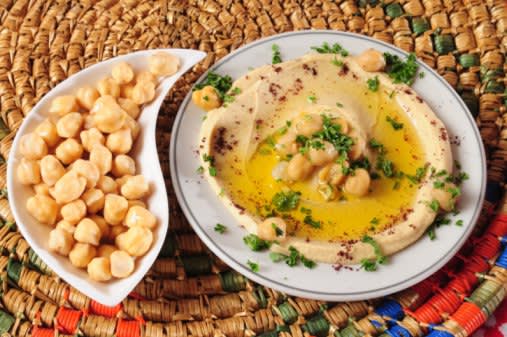 Turkish meze capitalises on the local ingredient of choice: olives. Whether it’s the clear golden liquid of quality olive oil added to humus, a contributing flavour or just a small plate before your main meal, expect it to feature heavily. Turkish food also relies heavily on dairy – yoghurt is a popular breakfast dish, but also contributes heavily to meze, often being mixed with aubergines or cucumbers to make a fresh, tangy dip. A huge variety of different Turkish cheeses are frequently used in meze dishes – if you like feta, tuck in! Finally, make sure you don’t miss out any dolma – these delicious stuffed vegetable packages are packed with flavour and never last long. An Authentic Kebab
Turkish meze capitalises on the local ingredient of choice: olives. Whether it’s the clear golden liquid of quality olive oil added to humus, a contributing flavour or just a small plate before your main meal, expect it to feature heavily. Turkish food also relies heavily on dairy – yoghurt is a popular breakfast dish, but also contributes heavily to meze, often being mixed with aubergines or cucumbers to make a fresh, tangy dip. A huge variety of different Turkish cheeses are frequently used in meze dishes – if you like feta, tuck in! Finally, make sure you don’t miss out any dolma – these delicious stuffed vegetable packages are packed with flavour and never last long. An Authentic Kebab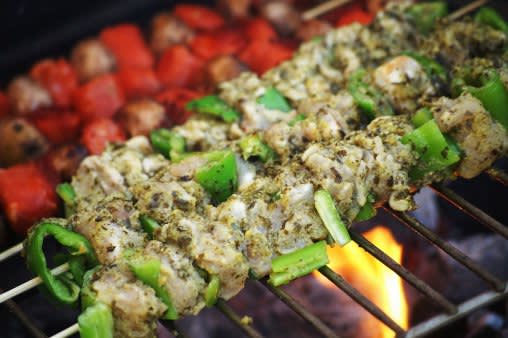 Britain has no idea how to produce a kebab. In the UK it has become a nocturnal stomach liner, which revolts in the cold light of the following morning. Not so in its birthplace. Just as the movie is never as good as the book, no imitation can beat the original. Real kebabs are a satisfying mix of lean, chargrilled meat, flavoured with a perfectly poised mix of herbs and spices, supported by a rush of fresh vegetables to add a crunch, laid down on a bed of thickly sliced juicy tomatoes. Often it doesn’t even come transportable in a wrap – and never needs to be doused in mayonnaise to hide its true flavour. Borek & Baklava
Britain has no idea how to produce a kebab. In the UK it has become a nocturnal stomach liner, which revolts in the cold light of the following morning. Not so in its birthplace. Just as the movie is never as good as the book, no imitation can beat the original. Real kebabs are a satisfying mix of lean, chargrilled meat, flavoured with a perfectly poised mix of herbs and spices, supported by a rush of fresh vegetables to add a crunch, laid down on a bed of thickly sliced juicy tomatoes. Often it doesn’t even come transportable in a wrap – and never needs to be doused in mayonnaise to hide its true flavour. Borek & Baklava Pastry performs in Turkey; it is both a sweet and savoury staple, a taste sensation whose versatility is half its appeal. Whilst not exclusively Turkish, we recommend sampling some borek, a pastry morsel made from layers of pastry padded out with cheese, minced lamb or vegetables. For those with a sweet tooth (a quintessentially Turkish trait), forget e-numbers and carbonated drinks and head straight for a natural sugar high with a plate of baklava. Layers of pastry are this time treated to strips of crushed nuts – pistachios, cashews, walnuts, you name it – and cemented together with a thick honey glue, covered in a honey glaze and generally saturated with the stuff. Menemen
Pastry performs in Turkey; it is both a sweet and savoury staple, a taste sensation whose versatility is half its appeal. Whilst not exclusively Turkish, we recommend sampling some borek, a pastry morsel made from layers of pastry padded out with cheese, minced lamb or vegetables. For those with a sweet tooth (a quintessentially Turkish trait), forget e-numbers and carbonated drinks and head straight for a natural sugar high with a plate of baklava. Layers of pastry are this time treated to strips of crushed nuts – pistachios, cashews, walnuts, you name it – and cemented together with a thick honey glue, covered in a honey glaze and generally saturated with the stuff. Menemen Essentially a Turkish equivalent to the humble omelette, menemen is a delicious egg dish which is surprisingly moreish. Scrambled eggs are combined with peppers, onion, tomatoes, black pepper and seasoned liberally with herbs to form an exciting one-pan explosion of flavour. Often it is consumed as a hearty breakfast with a slab of fresh bread, but it can be eaten at any time of day as a filling, flavoursome treat. When served in restaurants, it often comes in the pan it was cooked in and still sizzling with the heat of the fire. Pide
Essentially a Turkish equivalent to the humble omelette, menemen is a delicious egg dish which is surprisingly moreish. Scrambled eggs are combined with peppers, onion, tomatoes, black pepper and seasoned liberally with herbs to form an exciting one-pan explosion of flavour. Often it is consumed as a hearty breakfast with a slab of fresh bread, but it can be eaten at any time of day as a filling, flavoursome treat. When served in restaurants, it often comes in the pan it was cooked in and still sizzling with the heat of the fire. Pide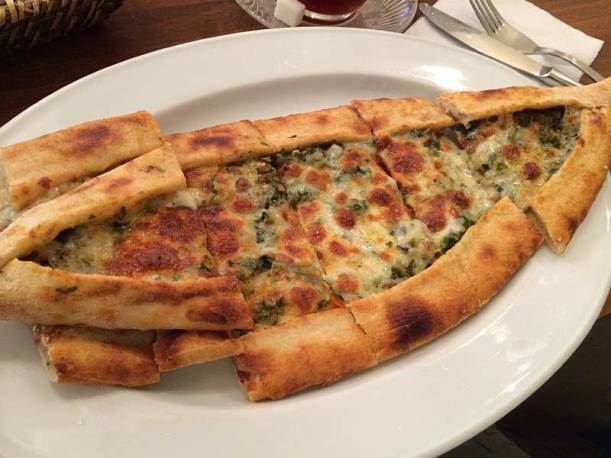 “Turkish pizza” as it is known, pide is essentially a half-opened calzone. A thick flatbread base is filled with other ingredients (these would represent your toppings – could be cheese, eggs, meat, spinach – essentially whatever you like) then flung into a traditional bakery oven to cook. This rough and ready destroyer of hunger is a hearty, comforting meal not to be treated as fine dining. Just get stuck in! If you’re lucky, you may see your chef constructing your pide in front of you. Çay (tea)
“Turkish pizza” as it is known, pide is essentially a half-opened calzone. A thick flatbread base is filled with other ingredients (these would represent your toppings – could be cheese, eggs, meat, spinach – essentially whatever you like) then flung into a traditional bakery oven to cook. This rough and ready destroyer of hunger is a hearty, comforting meal not to be treated as fine dining. Just get stuck in! If you’re lucky, you may see your chef constructing your pide in front of you. Çay (tea)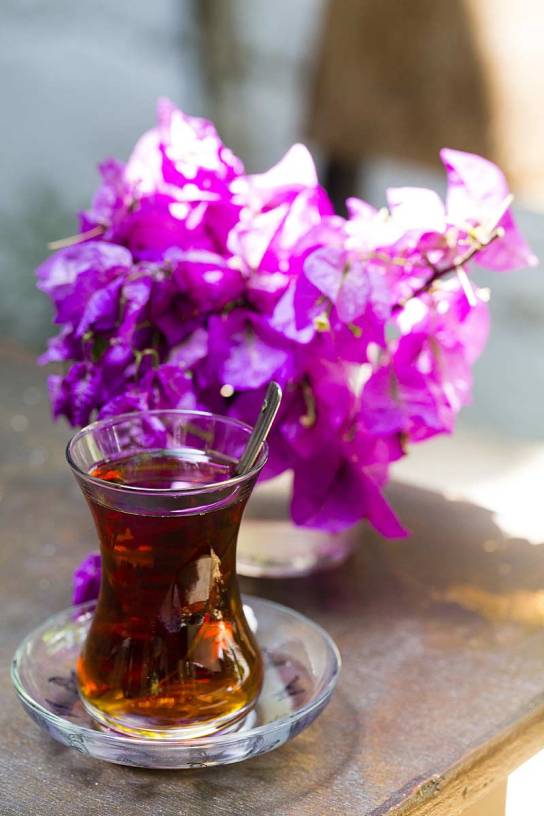 Turkish tea is stronger than an ox and sweeter than most desserts. It’s a crucial part of Turkish culture and is a social ritual of great importance. There are two main types to seek out: first is the black tea, çay, which is twice brewed and packs a real punch. The second is Turkish apple tea, sweet and sticky and the ideal mid-afternoon pick-me-up. If you don’t find yourself a fan immediately, it comes in small cups so no harm done. Turkish Delight
Turkish tea is stronger than an ox and sweeter than most desserts. It’s a crucial part of Turkish culture and is a social ritual of great importance. There are two main types to seek out: first is the black tea, çay, which is twice brewed and packs a real punch. The second is Turkish apple tea, sweet and sticky and the ideal mid-afternoon pick-me-up. If you don’t find yourself a fan immediately, it comes in small cups so no harm done. Turkish Delight Finally it wouldn’t be fair to end without mentioning that well-known icon, Turkish delight. This dessert has once against suffered at the hands of clumsy foreign interpreters, and the real stuff is a world away from what you’d purchase in an English supermarket. It is actually a delicate flavour, with hints of perfumed rosewater, light citrus fruitiness or sometimes with small slips of pistachio or walnuts inside to add a bit of indulgence. The dusty of icing sugar is merely to keep the glutinous cubes from sticking to each other in a hot mess, rather than a sickly sweet coating.
Finally it wouldn’t be fair to end without mentioning that well-known icon, Turkish delight. This dessert has once against suffered at the hands of clumsy foreign interpreters, and the real stuff is a world away from what you’d purchase in an English supermarket. It is actually a delicate flavour, with hints of perfumed rosewater, light citrus fruitiness or sometimes with small slips of pistachio or walnuts inside to add a bit of indulgence. The dusty of icing sugar is merely to keep the glutinous cubes from sticking to each other in a hot mess, rather than a sickly sweet coating.
